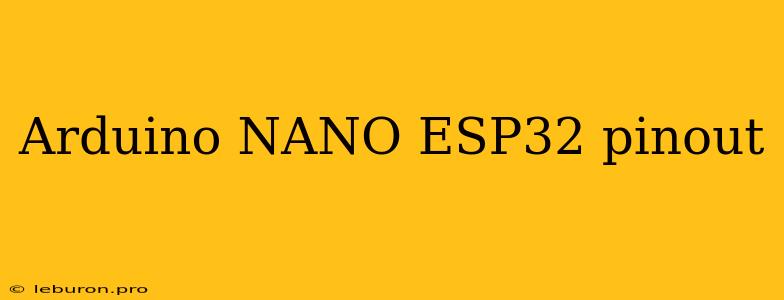The Arduino NANO ESP32 is a powerful and versatile microcontroller board that combines the features of the ESP32 chip with the familiar Arduino form factor. This makes it an excellent choice for a wide range of projects, from simple hobbyist applications to complex IoT deployments. One of the crucial aspects to understand when working with any microcontroller board is its pinout. This guide will delve into the Arduino NANO ESP32 pinout, exploring the various pins, their functions, and how they can be utilized in your projects.
Understanding the Arduino NANO ESP32 Pinout
The Arduino NANO ESP32 boasts a rich set of pins, each with its specific purpose. These pins can be categorized into different groups, helping you understand their functionalities better. The pinout diagram is typically printed on the board itself, providing a visual guide to their locations.
Digital I/O Pins
The Arduino NANO ESP32 comes with 26 digital input/output (I/O) pins. These pins are highly versatile and can be used for a variety of purposes.
- General Purpose I/O: These pins can be configured as inputs or outputs. When configured as inputs, they can read signals from external sensors or switches. As outputs, they can drive LEDs, motors, or other actuators.
- PWM Output: Many of the digital I/O pins can be configured for Pulse Width Modulation (PWM) output. This enables you to control the speed of motors or the brightness of LEDs.
- External Interrupts: Some digital I/O pins are capable of triggering interrupts on a change in their state. This allows the microcontroller to react quickly to events without constantly checking the pin's status.
Analog Input Pins
The Arduino NANO ESP32 also includes 10 analog input pins, numbered A0 to A9. These pins can be used to read analog signals from sensors such as potentiometers, temperature sensors, or light sensors.
Special Function Pins
The Arduino NANO ESP32 has several dedicated pins with specific functions:
- TX (Transmit): This pin transmits data over a serial communication channel.
- RX (Receive): This pin receives data over a serial communication channel.
- SPI Pins: These pins are used for Serial Peripheral Interface (SPI) communication.
- I2C Pins: These pins are used for Inter-Integrated Circuit (I2C) communication.
- SD Card Pins: These pins are used for connecting an SD card module.
Power Pins
The Arduino NANO ESP32 features a set of power pins:
- 5V: This pin provides a regulated 5V power supply.
- 3.3V: This pin provides a regulated 3.3V power supply.
- GND: This pin provides a ground reference.
How to Use the Arduino NANO ESP32 Pins
The Arduino IDE provides a user-friendly environment for programming the Arduino NANO ESP32. To utilize the pins, you'll typically use the following steps:
-
Declare the Pin: You'll need to declare the pin you wish to use within your code. For example, to use digital pin 2 as an output, you would declare it as:
const int ledPin = 2; pinMode(ledPin, OUTPUT); -
Set the Pin Direction: You need to specify if the pin will be an input or an output using the
pinMode()function. -
Read or Write Data: To read data from an input pin, use the
digitalRead()function. To write data to an output pin, use thedigitalWrite()function. -
Analog Input Reading: For analog input pins, use the
analogRead()function to read the analog value.
Example: Controlling an LED
This example code demonstrates controlling an LED connected to digital pin 2 on the Arduino NANO ESP32:
const int ledPin = 2;
void setup() {
pinMode(ledPin, OUTPUT); // Set digital pin 2 as output
}
void loop() {
digitalWrite(ledPin, HIGH); // Turn LED ON
delay(1000); // Wait for 1 second
digitalWrite(ledPin, LOW); // Turn LED OFF
delay(1000); // Wait for 1 second
}
Conclusion
The Arduino NANO ESP32 pinout is a vital piece of knowledge for any project utilizing this versatile board. Understanding the functions of each pin empowers you to connect a wide range of sensors, actuators, and communication interfaces. By leveraging the available pins, you can unlock the full potential of the Arduino NANO ESP32, allowing you to build innovative and powerful embedded systems.
